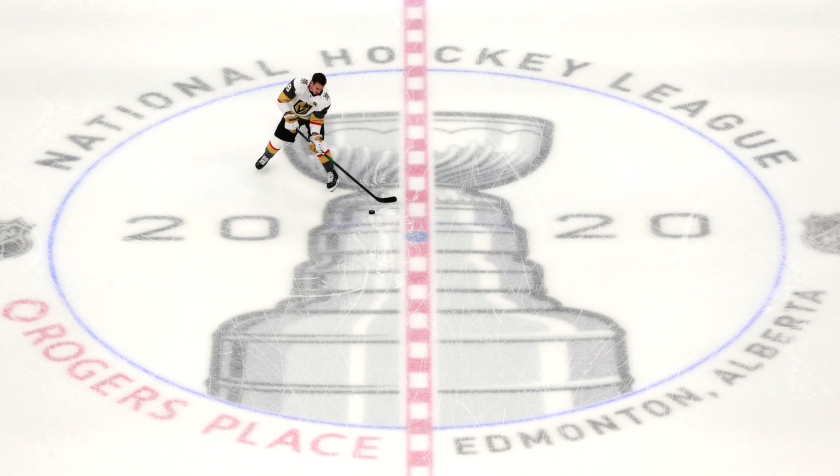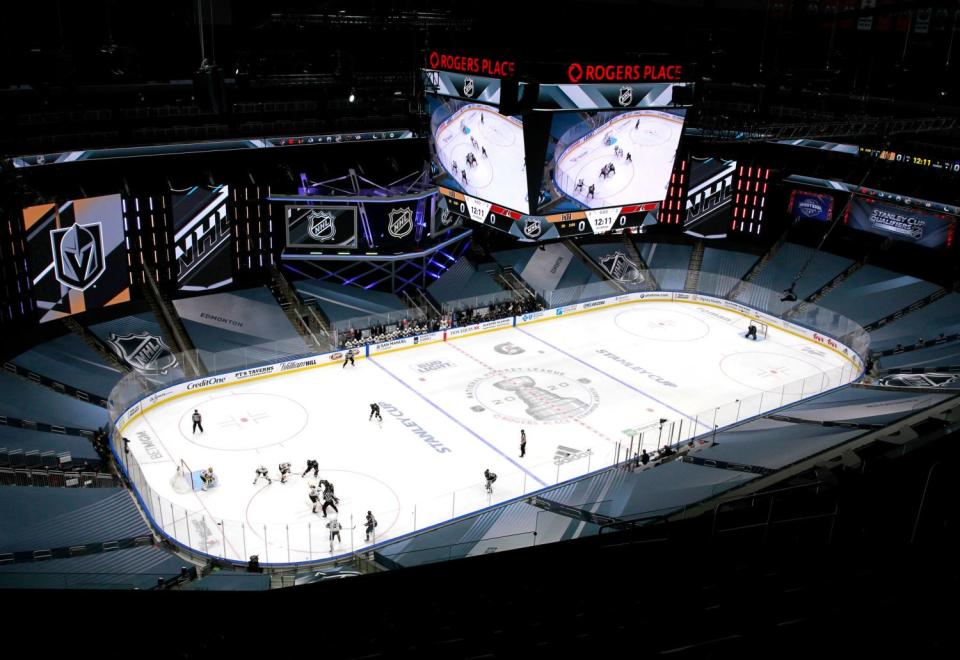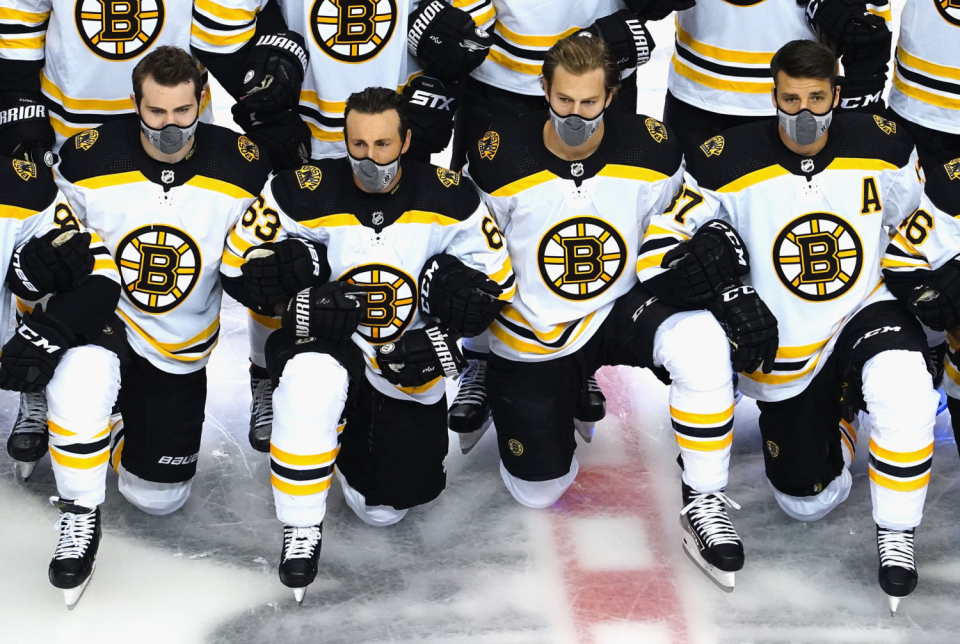Elliott: Amid unusual settings, NHL's return spurs optimism among players and coaches

What world is this, that hockey will be played in August and Commissioner Gary Bettman is winning praise for bringing the NHL back to life — safely so far — at a time of year the ice usually has long since melted?
Up is down and down has become up because the NHL is emerging as a leader in restarting North American sports. The twist was that to pull it off the league had to set up shop in Canada, where it created 12-team hubs in Toronto and Edmonton to house players until possibly early October. The NHL's brightest minds found the secret to keeping everyone happy as they undergo daily COVID-19 tests and follow strict health rules: Provide free coffee and donuts within teams’ fenced-off confines. Bettman had them at maple-glazed.
“I was probably pessimistic a couple of months ago when they started talking about this,” Rick Bowness, interim head coach of the Dallas Stars, said during a Zoom call held in Edmonton. “But coming here, it’s a wonderful feeling.”
The ultimate bubble hockey tournament will begin Saturday with best-of-five qualifying round games that offer a reprieve for teams that would have been excluded under the usual 16-team format. The 5 vs. 12, 6 vs. 11, 7 vs. 10 and 8 vs. 9 pairings leave room for upsets and — no small consideration — widen the circle to rope in the big markets of Montreal, Chicago and the New York Rangers.
On Sunday the top four teams in each conference will begin a round-robin mini-tournament to set seeding for the next round. All subsequent series will be best-of-seven and teams will be reseeded after each round.
“I think the team with the biggest mental strength, the strongest mental strength, is going to probably lift the Stanley Cup this year,” Edmonton Oilers goaltender Mike Smith said.
Everything can change quickly, as Major League Baseball learned when a COVID-19 outbreak hit the Miami Marlins and scrambled the schedule. But the NHL appears to have a strong chance to get this done with a minimum of glitches, especially since the league announced there were no positive results for COVID-19 among more than 800 players tested during the last week of training camp. Keeping players healthy then was the hard part. It’s easier to monitor them in the sanitized bubbles.
“The protocols have been working great and people have followed the rules and guidelines,” Boston Bruins center Patrice Bergeron said. “It seems very safe and we’re hopeful that we’ll be able to finish this playoff.”
Unlike in baseball but like the NBA in its bubble in Orlando, Fla., NHL players won’t hit the road. They’ll move only to the conference finals in Edmonton, also the site of the Stanley Cup Final.
“We’re not traveling, not going airplane to airplane,” Tampa Bay forward Patrick Maroon said. “It’s really scary. You don’t want to see players get [COVID-19]. If players do it right and make sure everyone is staying inside the bubble we’ll move forward and be successful.”
The most jarring new feature of bubble hockey, as seen on TV, is the absence of fans and the energy they generate. During exhibitions last week, crowd noise was piped into Toronto’s Scotiabank Arena and Edmonton’s Rogers Place and lower-bowl seats were covered by blue tarpaulins. The noise was fine after goals but during play — when it apparently was meant to simulate conversations in a populated arena — it was more annoying than lively. Better to hear players’ chatter. And additional camera angles didn’t always enhance the viewing experience.

Aspects of game presentation can be changed. The empty seats will remain. “It was kind of weird,” Washington Capitals winger Alex Ovechkin said, “but there’s nothing we can do about it.”
Not that there’s a bright side to a pandemic-induced delay, but the 142-day pause gave a second chance to some players who otherwise might have missed the playoffs. Among them are Vancouver goalie Jacob Markstrom (knee), Pittsburgh forward Jake Guentzel (shoulder) and Columbus defenseman Seth Jones (ankle).
“It’s a little bit of a blessing in disguise,” Jones said.
Normally, predicting the course of the playoffs would include analyzing regular-season statistics and noting which teams were hot down the stretch. This season being decidedly abnormal, traditional thinking is worthless. Winning streaks that were impressive in March are meaningless now. Plus, there’s the added wrinkle of the short qualifying round, a new experience for many players and coaches.
“In best-of-five your margin for error is slim,” Edmonton coach Dave Tippett said, “so you’d better be on top of your game from the start.”
Tippett’s Oilers, seeded No. 5 in the West, should overpower No. 12 Chicago. No. 6 Nashville must choose between fading veteran goalie Pekka Rinne and 25-year-old Juuse Saros and could be vulnerable to an upset by No. 11 Arizona. No. 7 Vancouver, led by rookie of the year finalist Quinn Hughes, should defeat No. 10 Minnesota if it can rekindle its power-play success. No. 8 Calgary and No. 9 Winnipeg were a point apart during the regular season but Calgary will miss defenseman Travis Hamonic, who opted out for family reasons. Winnipeg goalie Connor Hellebuyck could be the difference maker.
Defending champion St. Louis will vie with Colorado, Vegas and Dallas for the top seeding in round-robin play.
The Bruins led the East with 100 points in 70 games but struggled to assemble a full roster during training camp because of injuries and quarantine issues faced by players who returned from Europe. The Bruins must develop cohesion during the round-robin against Tampa Bay, Washington, and Philadelphia.

The No. 5 Penguins didn’t have Sidney Crosby for part of training camp but he played in their exhibition; the No. 12 Canadiens are fortunate to be part of the postseason party. No. 6 Carolina has a goaltending dilemma (James Reimer or Petr Mrazek) against the No. 11 Rangers, who face a similar choice. Henrik Lundqvist has a solid career record against Carolina but Igor Shesterkin has moved ahead of him on the depth chart. No easy pick there.
The Islanders, seeded No. 7, are stronger defensively than No. 10 Florida, which has dynamic young forwards but gives up too many goals. Sheldon Keefe, who took over as coach of the No. 8 Maple Leafs when Mike Babcock was fired last November, played in Tampa Bay for John Tortorella, coach of the No. 9 Blue Jackets.
“I wish nothing but the best for the guy, other than this series,” said Tortorella, whose experience could give him the edge.
If all goes well, Bettman will hand off the Cup in late September or early October. Without fans in the stands, he can be sure of a cordial reception.
“I think it’s going to be one of the most remembered Stanley Cups, for a long time. Maybe ever,” Nashville center Ryan Johansen told NHL.com.
May this return to play be remembered for being done safely and sanely in a year safety and sanity have been in alarmingly short supply.

